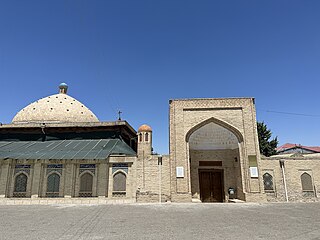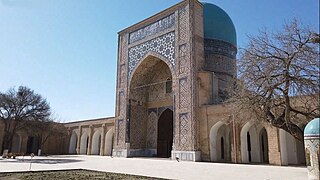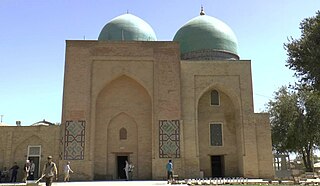
Chor-Bakr is a memorial complex in the village of Sumitan at 5 km of Bukhara in Uzbekistan, built over the burial place of Abu-Bakr-Said, who died in the year 360 of the Muslim Calendar, and who was one of the four of Abu-Bakrs (Chor-Bakr) – descendants of Muhammad. The complex includes the necropolis of family tombs, and courtyards enclosed with walls.

Dor-i-Tilavat - in the center of Shahrisabz, in the west of the Darussiodat complex, there is a complex consisting of ancient structures belonging to the Timurid dynasty - the tomb of Shamsuddin Kulol, Gumbazi Sayyidon, and the Blue Dome Mosque, built on the site of the old madrasa here.

Maghoki Attori Mosque is a historical mosque in Bukhara, Uzbekistan. It forms a part of the historical religious complex of Lyab-i Hauz. The mosque is located in the historical center of Bukhara, about 300 meters southwest of Po-i-Kalyan, 100 meters southwest of the Toqi Telpak Furushon trading dome and 100 meters east of Lab-i Hauz. It is a part of UNESCO World Heritage Site Historic Centre of Bukhara. Today, the mosque is used as a carpet museum.

The Zawiya of Sidi Bel Abbes or Zaouia of Sidi Bel-Abbès is an Islamic religious complex (zawiya) in Marrakesh, Morocco. The complex is centered around the mausoleum of Abu al-Abbas as-Sabti, a Sufi teacher who died in 1204. He is the most venerated of the Seven Saints of Marrakesh, generally considered the "patron saint" of the city. The zawiya's architecture dates in part to the late Saadian period but has been modified and restored multiple times since then.

Odina Mosque is the oldest preserved architectural monument located in the city of Qarshi, Qashqadaryo region. The mosque is situated in the center of the Qarshi fortress. Timur, during his expedition from Samarkand to Qarshi in 1385-1386, ordered the construction of this mosque.

The Pahlavon Mahmud complex, Pahlavon Mahmud mausoleum or Polvon ota mausoleum is a memorial monument in Khiva, Khorezm. The mausoleum complex has a total area of 50x30m, and was originally built in 1664 as a miraculous dome over the grave of Pahlavon Mahmud. Pahlavon Mahmud (1247-1326) was a local poet who emerged from humble craftsmen, and was also famous for his heroic strength as an unbeatable wrestler, and his ability to heal people. His tomb has been and is still considered a sacred place by representatives of Uzbeks, Turkmens, Karakalpaks and other peoples. This complex is also known in Khiva as “Hazrati Pahlavon Pir”.

Pansod Mosque is a historical monument in Shahrixon, Uzbekistan, dating back to the early 20th century. It is located 27 km away from Andijan city.

The Hazrat Khizr Mosque is a historical monument in Samarkand ; associated with the name of the legendary Islamic prophet Khizr. The building was erected on the site of an ancient mosque. The monument is located opposite the Shah-i-Zinda complex on a hill. In 2018, the mausoleum of the First President of the Republic of Uzbekistan Islam Karimov was opened in the territory of the mosque.

Qaffol Shoshi mausoleum is a mausoleum in Tashkent, Uzbekistan, built in honor of Imam Abu Bakr Muhammad ibn Ali ibn Ismail al-Kaffal ash-Shashi. The original tomb did not survive in its initial form. In its current state, the mausoleum was constructed in 1542 by the royal architect of that time, Gulyam Husayn. It is an asymmetrical domed portal mausoleum, known as a khanqah. Khanqahs were designed to provide pilgrims shelter in residential places called “khujrahs”. Mausoleum complexes often included a mosque and a kitchen. To the south of the main building in a small courtyard, there are later burial places (saganas).

The Xalfa Xudoydod Complex is an architectural monument in Bukhara Region, Uzbekistan. The complex was built by Sheikh Xudoydod ibn Toshmuhammad Azizon al-Bukhari in 1777–1855, during the reign of the Manghit dynasty in Bukhara Emirate. The complex consists of a madrasa, a mosque, a house, a cistern and a cemetery.
The Hazrati Bashir Mausoleum is a cultural heritage object located in Uzbekistan. The object was built in the 18th century. Hazrati Bashir mausoleum is located in the Bashir village of Kitob district, Qashqadaryo region. According to the rights of immovable property, it is considered state property on the basis of the operational management right of the Qashqadaryo region cultural heritage administration.

The Langar Ota Mausoleum is a cultural heritage site in Uzbekistan. It is located in the Kokbulok mahalla of Qamashi District of Qashqadaryo region, and was built in the 15th century. Currently, this area is under the operational management of the Kashkadarya Regional Department of Cultural Heritage. It is entrusted to the “Waqf” charity foundation on the basis of a free use agreement. The Langar Ota Mausoleum was included in the National Register of Immovable Cultural Heritage Objects by the decision of the Cabinet of Ministers of the Republic of Uzbekistan on October 4, 2019. The Langar Ota Mausoleum is under state protection.
The Sirli Mosque is an architectural monument located on Kokand Street in Namangan city, Namangan Region, Uzbekistan. It was built in the 19th century or in the early 20th century in the village of Tepakurgan.
The Kosonsoy Congregational Mosque is a historical monument in Namangan, Uzbekistan. It is built on a courtyard surrounded by a wall. It can be entered through a portal with a dome on the south side, or through a carved door on the west side that leads to a rectangular mosque. The west wall has a three-niche mihrab. The external dome is supported by four arches. The four arches are based on four side wings, which are themselves supported by separate or wall-attached wooden columns. The building is mainly decorated with two colors. The portal is simple, but elegant, with a row of small arches on the upper part, ending with a cornice, and surrounded by flat arches. The portal has a dome on each corner. In 1993, a veranda, classrooms and other additional buildings were constructed. The Kosonsoy Jome Mosque is the only prayer-style building in the Fergana Valley, and reflects the skill of local architects in construction.
The Mavlonbuva Mausoleum is an architectural monument located in the Namangan Region of Uzbekistan. The mausoleum was built in 1806 and is a unique place of worship for poets, who left many verses on its walls.
The Podsho Pirim Complex is an architectural monument located in the village of Bekobod in the Buvaydin district of the Fergana region of Uzbekistan. The complex consists of a graveyard, a mausoleum, a darvaza-khana, and a shrine. The main structure of the complex is the mausoleum of Shah-i Jari. Most of the complex was built in between 15th and 16th centuries, but there are also buildings dating from the 20th century.

Termizi Memorial Complex, Hakim Termezi Mausoleum, is a historical site in Termez, Uzbekistan. Al-Hakim al-Termezi Mausoleum, considered sacred for Muslims, is situated in the ancient part of Termez. It houses the tomb of Abu Abdullah Muhammad Hakim Termezi, a prominent Islamic scholar, author of various philosophical and religious works, and the founder of a group of dervishes. The complex is associated with Abu Abdullah Muhammad Hakim Termezi. This mausoleum houses the grave of Termezi. The Termezi Memorial Complex has been reconstructed several times throughout the centuries. Today, this complex is considered one of the primary pilgrimage sites for visitors and guests of the province.
The Sharifboy Madrasa is one of the historical and cultural monuments located in Chaqar district of Qarshi city, Qashqadaryo Region. Sharifboy madrasa was included in the National Register of Immovable Property Objects of the Material and Cultural Heritage of Uzbekistan according to the Decree of the President of the Republic of Uzbekistan "On measures to radically improve the activities in the field of preservation of material and cultural heritage objects" dated December 19, 2018 No. PQ-4068 — taken under state protection.

Kuk Gumbaz Mosque is an architectural monument located in Shahrisabz, Qashqadaryo Region, Uzbekistan. The mosque was built between 1434 and 1435 by Ulug Beg Mirzo for his father Shah Rukh Mirzo. Historical inscriptions with the names of the Timurids and the time of construction have been preserved in the porch of the mosque.

Shamsuddin Kulol Mausoleum is an architectural monument located in the city of Shahrisabz, Qashqadaryo Region, Uzbekistan. It was built on the grave of Amir Temur's father Amir Taragoi and Shamsuddin Kulol, Temur's teacher. The Shamsuddin Kulol Mausoleum is the first example of a new architectural style formed during the period of Amir Temur, especially the structure under the dome inside the building – intersecting arches and shield-like decorations between them had an important influence on the architectural style. Shamsuddin Kulol mausoleum is located in the "Dorut Tilavat" complex.














